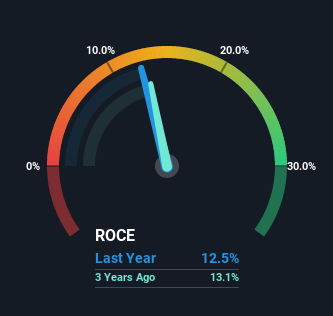If we want to find a stock that could multiply over the long term, what are the underlying trends we should look for? Firstly, we'd want to identify a growing return on capital employed (ROCE) and then alongside that, an ever-increasing base of capital employed. This shows us that it's a compounding machine, able to continually reinvest its earnings back into the business and generate higher returns. However, after briefly looking over the numbers, we don't think HPL Electric & Power (NSE:HPL) has the makings of a multi-bagger going forward, but let's have a look at why that may be.
What Is Return On Capital Employed (ROCE)?
For those who don't know, ROCE is a measure of a company's yearly pre-tax profit (its return), relative to the capital employed in the business. To calculate this metric for HPL Electric & Power, this is the formula:
Return on Capital Employed = Earnings Before Interest and Tax (EBIT) ÷ (Total Assets - Current Liabilities)
0.13 = ₹1.1b ÷ (₹16b - ₹7.9b) (Based on the trailing twelve months to June 2022).
Thus, HPL Electric & Power has an ROCE of 13%. That's a pretty standard return and it's in line with the industry average of 13%.
Check out the opportunities and risks within the IN Electrical industry.

Historical performance is a great place to start when researching a stock so above you can see the gauge for HPL Electric & Power's ROCE against it's prior returns. If you want to delve into the historical earnings, revenue and cash flow of HPL Electric & Power, check out these free graphs here.
What The Trend Of ROCE Can Tell Us
Things have been pretty stable at HPL Electric & Power, with its capital employed and returns on that capital staying somewhat the same for the last five years. Businesses with these traits tend to be mature and steady operations because they're past the growth phase. So unless we see a substantial change at HPL Electric & Power in terms of ROCE and additional investments being made, we wouldn't hold our breath on it being a multi-bagger.
On a separate but related note, it's important to know that HPL Electric & Power has a current liabilities to total assets ratio of 48%, which we'd consider pretty high. This effectively means that suppliers (or short-term creditors) are funding a large portion of the business, so just be aware that this can introduce some elements of risk. Ideally we'd like to see this reduce as that would mean fewer obligations bearing risks.
The Bottom Line On HPL Electric & Power's ROCE
We can conclude that in regards to HPL Electric & Power's returns on capital employed and the trends, there isn't much change to report on. Since the stock has declined 35% over the last five years, investors may not be too optimistic on this trend improving either. In any case, the stock doesn't have these traits of a multi-bagger discussed above, so if that's what you're looking for, we think you'd have more luck elsewhere.
One final note, you should learn about the 3 warning signs we've spotted with HPL Electric & Power (including 2 which are a bit unpleasant) .
While HPL Electric & Power may not currently earn the highest returns, we've compiled a list of companies that currently earn more than 25% return on equity. Check out this free list here.
Valuation is complex, but we're here to simplify it.
Discover if HPL Electric & Power might be undervalued or overvalued with our detailed analysis, featuring fair value estimates, potential risks, dividends, insider trades, and its financial condition.
Access Free AnalysisHave feedback on this article? Concerned about the content? Get in touch with us directly. Alternatively, email editorial-team (at) simplywallst.com.
This article by Simply Wall St is general in nature. We provide commentary based on historical data and analyst forecasts only using an unbiased methodology and our articles are not intended to be financial advice. It does not constitute a recommendation to buy or sell any stock, and does not take account of your objectives, or your financial situation. We aim to bring you long-term focused analysis driven by fundamental data. Note that our analysis may not factor in the latest price-sensitive company announcements or qualitative material. Simply Wall St has no position in any stocks mentioned.
About NSEI:HPL
HPL Electric & Power
Manufactures and sells electric equipment under the HPL brand in India.
Solid track record with adequate balance sheet.
Market Insights
Community Narratives




